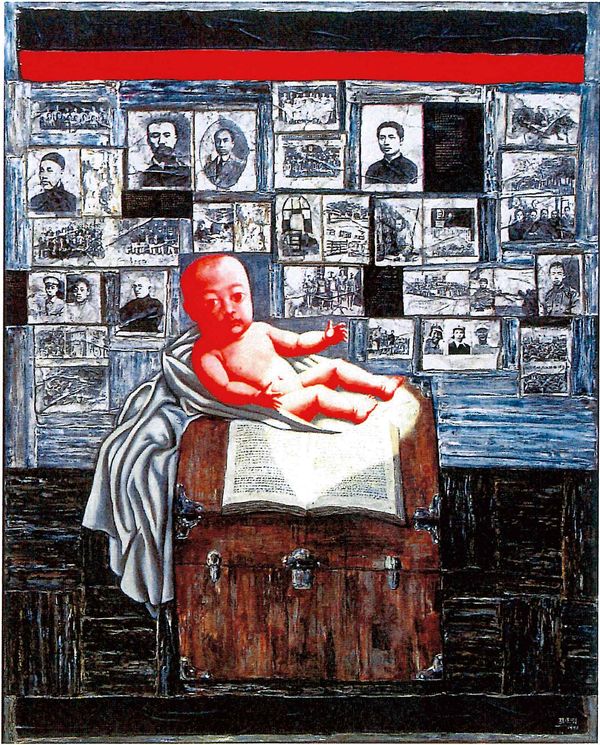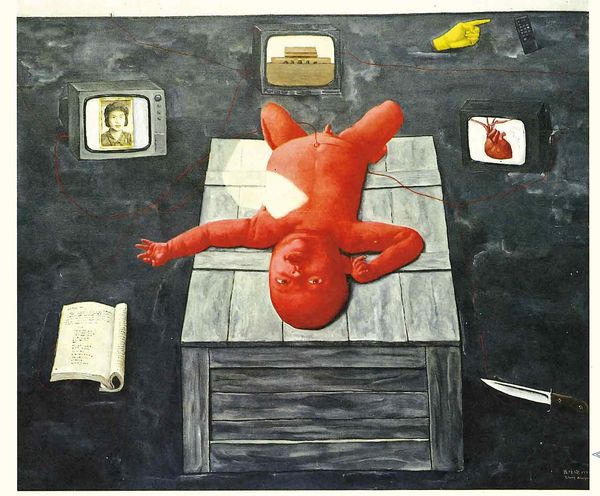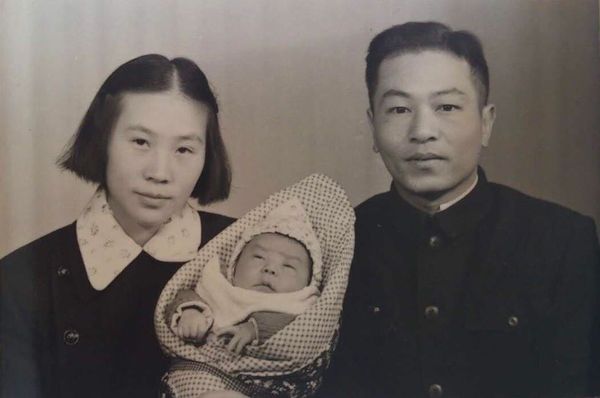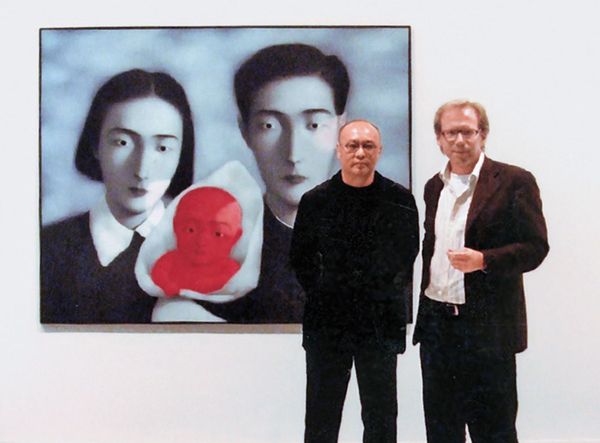Zhang Xiaogang Bloodline: Big Family 9, 1996
This April at Phillips Hong Kong, we sat down with Zhang Xiaogang. The artist shared the inspiration and development behind Bloodline: Big Family No. 9, the influence it has had on his later works and the significance this seminal work has had on his career.
Phillips: Mr. Zhang, the Bloodline series is considered to comprise some of your most important works. Can you enlighten us with regards to the story behind it and possibly share some of your memories with us?
Zhang Xiaogang: I have been working on the Bloodline paintings on and off since 1994, so this series represents an important phase in my life. Overall, the Bloodline series contains some of my most representative works and, around a decade ago, its development came to a halt.
P: We are curious about the photographs on which the Bloodline series are based and how old photos impact your work. You have cited Gerhard Richter as an artist who greatly inspires you; has his use and manipulation of photography influenced your work?
ZX: In 1992, when I traveled throughout Germany, Richter inspired me the most as a contemporary artist. I was not expecting this; at the time, Richter had little exposure in China. It was also impossible to gauge his level of influence and social standing. When I was in Germany, where Expressionism prevailed, Richter's works were truly a breath of fresh air. In the past, artists used photographs in the painting process, but only as informational tools and reference points. Richter, however, looked at photos and saw their history and meaning, which greatly inspired me. I started to pay attention to the history, culture and aesthetics behind pictures and distilled these things into my own artistic language. Through old pictures, I was able to learn about the ideas of traditional Chinese aesthetics, including how people delighted in the process of taking and developing film. They also went to great lengths to beautify the subjects of their pictures, just like how we still are constantly refining history and polishing memories. I also went through my own process of refining old photos—though, my purpose was to reconstruct old memories. For me, the journey from old photos to my Bloodline series was a process of re-embellishing.
The 'Bloodline' series represents one of the most important periods and turning points of my artistic career.
— Zhang Xiaogang
P: In the 1990s you were part of several seminal Biennales, including the 1994 São Paulo Biennale and the 1995 Biennale. We would like to hear how these academically-important exhibitions affected your work in the 90s.
ZX: My participation in these important international exhibitions came after the birth of my Bloodline series; it was like a door had opened for me. This is why the Bloodline series represents one of the most important periods and turning points of my artistic career. After my works were being offered on the art market, people started to interpret my work from different angles—some thought it was a political symbol—but none of that truly mattered. There are certain works whose meanings can only be understood through a unique historical context. The Bloodline series is bound to the times in which it was created; it is also the fruit of more than a decade's worth of artistic endeavors. Those who grew up in the West are able to separate themselves from politics if they so choose; this is impossible for someone who grew up in China. Starting in kindergarten, you are confronted by politics that permeate every aspect of your life. For Chinese people, politics is not an art form; it's daily life, it's something you face every day. So a Chinese person's memory is filled with politics.
Your personal life and petty emotions become insignificant in the presence of greater times. I am more concerned with personal memories. I believe that large memories are accumulated from small memories, and that is why I chose to approach my work from a familial angle. Families are basic units of little memories, but they contain the memories of the entire nation and its people. The '90s were a very different era from the present. At the time, having just lived through the '80s, Chinese artists were immediately confronted with new issues of self-identity and contemporary art knowledge — issues that were relatively focused and simple. As a result, artists had to assume strong and distinguishable characters that left little room for ambiguity. In retrospect, I realize that you need to know exactly what you want to express.
Zhang Xiaogang Genesis Number One, The Birth of a Republic, 1991
Zhang Xiaogang Red Baby, 1993. Collection of Johnson Tsong-zung Chang
P: Let's return to Bloodline: Big Family No. 9. You created this work in 1996, and it is deeply connected to your family. Could you perhaps expand on the story behind the work?
ZX: Specifically, the material for this painting came from a family photo. The photo shows my parents and my older brother — the first child of my family — and was taken to celebrate his hundredth-day birthday. When my brother was a child, he was a bit cross-eyed, so that adds a certain liveliness to the picture. I selected this picture from a pile and changed the child in the photo to one that represents our generation. I painted the child red to symbolize the "Second-generation Reds," the product of new China. The image of every figure in my Bloodline series is a variation of my mother — and because they are all the same person, I do not assign a sex to them.
P: Your work represents an entire generation instead of individuals.
ZX: Yes, it was part of my thinking to see myself within a larger cultural context, so what I portray is not individuality.
Zhang Xiaogang's elder brother with their parents, on the occasion of his 100th Day Celebration
P: The current collector of Bloodline: Big Family No. 9 has been in possession of the work for many years. He also stated that this piece has special meaning to you.
ZX: I believe that this piece is very representative of my work. I still remember painting it and recall each detail vividly along the way. Halfway through the process, Wei Guangqing, Wang Guangyi and Fang Lijun came to visit me in my studio. Wei asked me how I treated the relationship between the characters and their background. I had completed several pieces in my Chengdu studio, all of which are among my most important works. I remember feeling a particular connection to this piece. I can't quite remember if I started out working on it in my Chongqing studio and finished it in my Chengdu studio or if it was the other way around. Either way, I created this piece between the two studios. The timing was also interesting because I painted it in 1995-96 when I was still teaching at the China Academy of Art.
P: We touched on the fact that your previous works were more expressionist, which is quite different from your current works. How have you altered your subject matter, content and artistic language, and what is the relationship between these factors?
ZX: It all started with The Birth of a Republic, which was the first time I used a photograph in my painting process; it was the spark that gave me a clue and a reason to use photos in my future practice. I was gathering information in the library and randomly came across an old photo of senior Communist members during the Republic of China. I found it an attractive image and decided to use it — to make it the cultural background of my painting. It wasn't until the end of 1993 that I truly started to read and learn from old family photos. That was the moment when I realized that everything I needed was right there. I set everything else aside and completely shifted my focus to studying pictures, which led to the subsequent creation of my Bloodline series. In the following years, I would keep a record of all the ideas that came to mind. I had always been intrigued by memories, but studying photos really enhanced this interest and allowed me to translate old emotions onto canvas. In recent years, my methods have changed; what has remained the same is my quest for finding possibilities within memories.
Collector Nick Scheeres with Zhang Xiaogang in front of Bloodline: Big Family 9, 1996
P: There is still much Romanticism in your work. In terms of your methods, when we were going through your work, we noticed the extremely delicate way that Bloodline: Big Family No. 9 was rendered — the gentle brushstrokes, the background clouds, and drops of water on the faces. We'd love to know more about your special techniques and how you employ them.
ZX: It took me about a year of continual trial and error before I was able to perfect the techniques I used in the Bloodline series. At the time, I rather enjoyed the cryptic meanings hidden beneath a seemingly tranquil atmosphere. In February of 1994, I started to hone my techniques and explore my understanding of shapes (I had always striven to establish my own system for understanding and using shapes) by repeatedly painting the same painting. That year, I studied every detail and minutiae in my paintings, and through repeated experimentation, I found that creating multiple layers was essential for achieving the desired effect. I also aspired to capture light in my paintings — especially soft light — which is often observed in old photos. Soft light gives a sense of history, of changing times and of poetry. Creating multiple layers was a painstaking and time-consuming method, but I came to the conclusion that at least three layers were needed — black, white and grey — to achieve the effect I wanted. Suffice it to say that I was overjoyed when I finally perfected this technique.
P: This has been very enlightening, Mr. Zhang. Thank you very much for the in-depth explanation of your work.




